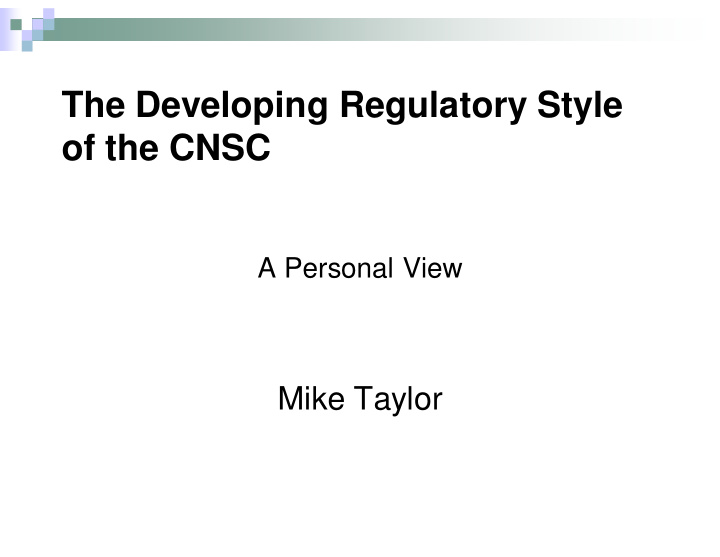



The Developing Regulatory Style of the CNSC A Personal View Mike Taylor
This Talk � A quick overview of the CNSC � My experience as an indication of changes � Development of Canada’s regulatory style in contrast to other nuclear power countries. � Some Influences for change � Does the Canadian System work? � My conclusion � Discussion
CNSC Organisation
2000-Organization
2004 - Organization
� The CNSC consists of: � a) The Commission ~ 7 independent persons appointed by the Governor-in- Council � b) The staff. – (~ 500 people) advises the Commission and performs compliance, assessment and administration
Objectives of the Commission ( a ) to regulate the development, production and use of nuclear energy and the production, possession and use of nuclear substances, prescribed equipment and prescribed information in order to (i) prevent unreasonable risk, to the environment and to the health and safety of persons, associated with that development, production, possession or use, (ii) prevent unreasonable risk to national security associated with that development, production, possession or use, and (iii) achieve conformity with measures of control and international obligations to which Canada has agreed; and ( b ) to disseminate objective scientific, technical and regulatory information to the public concerning the activities of the Commission and the effects, on the environment and on the health and safety of persons, of the development, production, possession and use referred to in paragraph ( a ).
How did the CNSC get to where it is?
AECB/CNSC HISTORY � Atomic Energy Control Act 1949 � Gradual increase in staff � Significant change in regulatory style � Nuclear Safety & Control Act � Royal Assent 1997 � Came into force May 2000 � Staff re-organisation
Some Experiences - indicators of change
Where is the CNSC in The World Regulatory Spectrum? Spectrum: “The entire range of anything arranged by degree or quality”
What is the axis of a regulatory spectrum? • Examples • Degree of prescription • Degree of regulatory independence • Size of the industry • Transparency • Regulatory scope
Degree of prescription
No Prescription
Prescription
Prescription US CAN FRA UK Very Less
Size of the industry (and types of plant)
[Power Reactors in operation or construction] � USA 104 � France 59 � Japan 53 � Russia 30 � South Korea 20 � UK 19 � Canada 18 � Germany 17 � Ukraine 15 � China 11 � Sweden 10
Size of the Industry USA FRA JAP UK CAN SWE ����� �����
Transparency
Transparency USA CAN UK RUSSIA ���� ������
Where is Canada? Small size Little transparency Non prescriptive CAN Large size Very transparent Prescriptive
Canada Changing Position In the Regulatory Spectrum � Stakeholder demands � Government � Value for money � Licensees � Regulatory certainty � Controlled costs � Public � Transparency/ Confidence � International � Consistency/ Acceptable standards
Canada’s Changing Position In the Regulatory Spectrum � Some factors: � Privatization � Market Deregulation � Cost Recovery � Environment � Security � Decommissioning � Infrastructure
Canada’s Changing Position In the Regulatory Spectrum � The Leader
How is the CNS doing?
Objectives of the Commission ( a ) to regulate the development, production and use of nuclear energy and the production, possession and use of nuclear substances, prescribed equipment and prescribed information in order to (i) prevent unreasonable risk, to the environment and to the health and safety of persons, associated with that development, production, possession or use, (ii) prevent unreasonable risk to national security associated with that development, production, possession or use, and (iii) achieve conformity with measures of control and international obligations to which Canada has agreed; and ( b ) to disseminate objective scientific, technical and regulatory information to the public concerning the activities of the Commission and the effects, on the environment and on the health and safety of persons, of the development, production, possession and use referred to in paragraph ( a ).
Some Measures of Regulatory Effectiveness � Peer Review – IRRT � Benchmarking � Quality Assurance � Auditor General � NEA Indicators * � Outreach/Feedback
NEA Indicators � Ensures acceptable level of safety � Adequate level of competence � Prevent safety degradation & promote improvements � Timely & cost effective,- confidence of operating organisations, public, government
� Timely & cost effective � Confidence of operating organisations, public, government � Commission process significant here � Balance of public/industry interests � Independence of Tribunal � Quality of inputs � Quality of decisions
Conclusion � Doing a job appropriate to the current environment with respect to regulation
� ( b ) to disseminate objective scientific, technical and regulatory information to the public concerning the activities of the Commission and the effects, on the environment and on the health and safety of persons, of the development, production, possession and use referred to in paragraph ( a ).
Information � Serious need for objective public info. � Difficult for the CNSC to be seen by all stakeholders as “objective’
No nuclear waste around here
Yucca Mountain
Conclusion � Not such a good job – but probably the Act is misplacing the onus.
Recommend
More recommend